Nursing Essay: Applying Child Development Theories in Nursing
VerifiedAdded on 2020/03/23
|6
|1588
|34
Essay
AI Summary
This essay delves into the cognitive and social development of a three-year-old child, Jack, from a nursing perspective, using the theories of Piaget and Erikson. The essay examines Jack's development, highlighting the pre-operational stage and egocentrism as described by Piaget, and Erikson's stages of social development. It analyzes how Jack's language limitations, toileting skills, and interactions with his environment relate to these theories. The essay emphasizes the interconnectedness of cognitive and social development, and the significance of understanding these developmental stages for effective nursing care, particularly in a childcare setting. The paper concludes by highlighting the crucial role of nurses in supporting children to achieve developmental milestones.
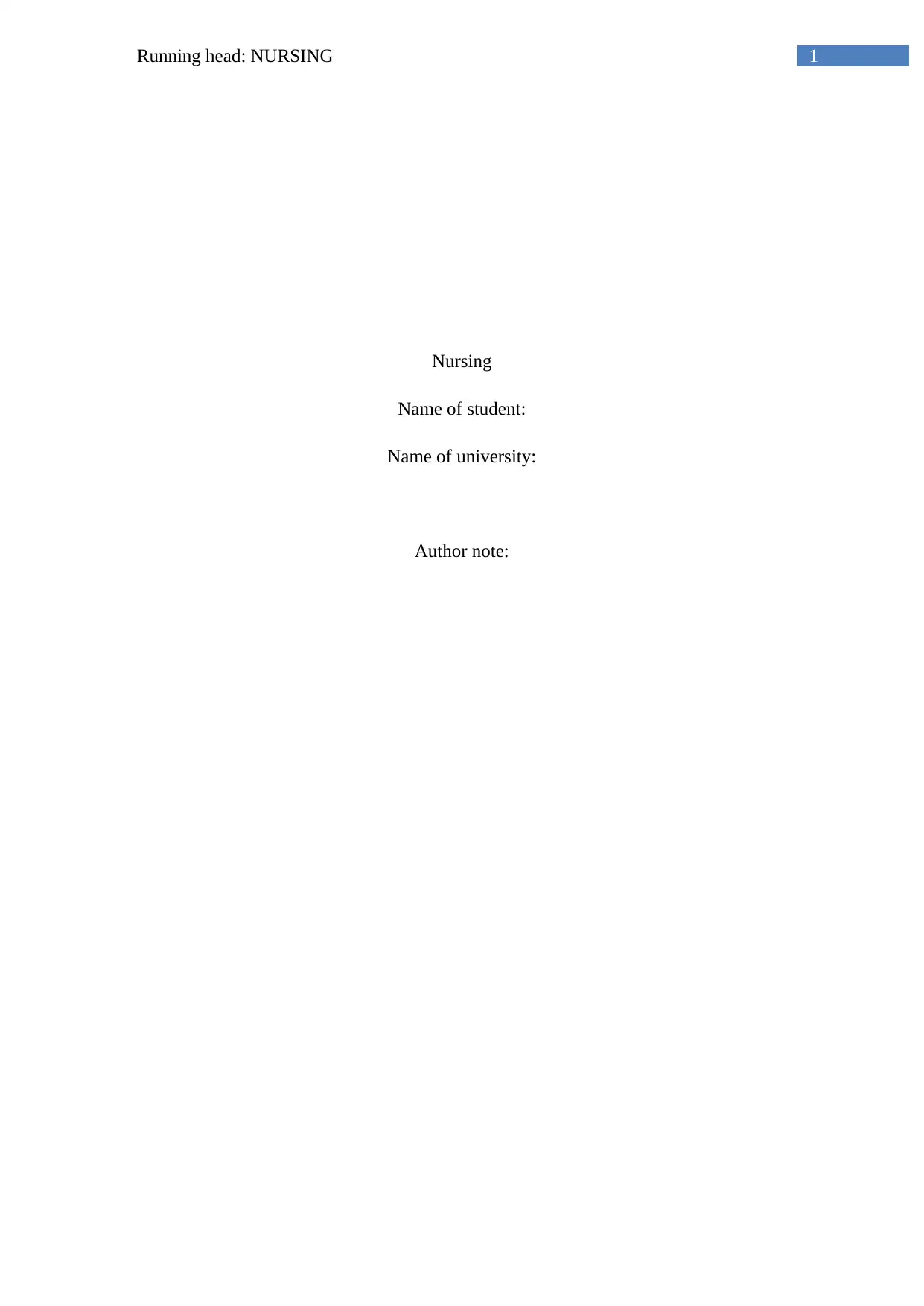
1Running head: NURSING
Nursing
Name of student:
Name of university:
Author note:
Nursing
Name of student:
Name of university:
Author note:
Paraphrase This Document
Need a fresh take? Get an instant paraphrase of this document with our AI Paraphraser
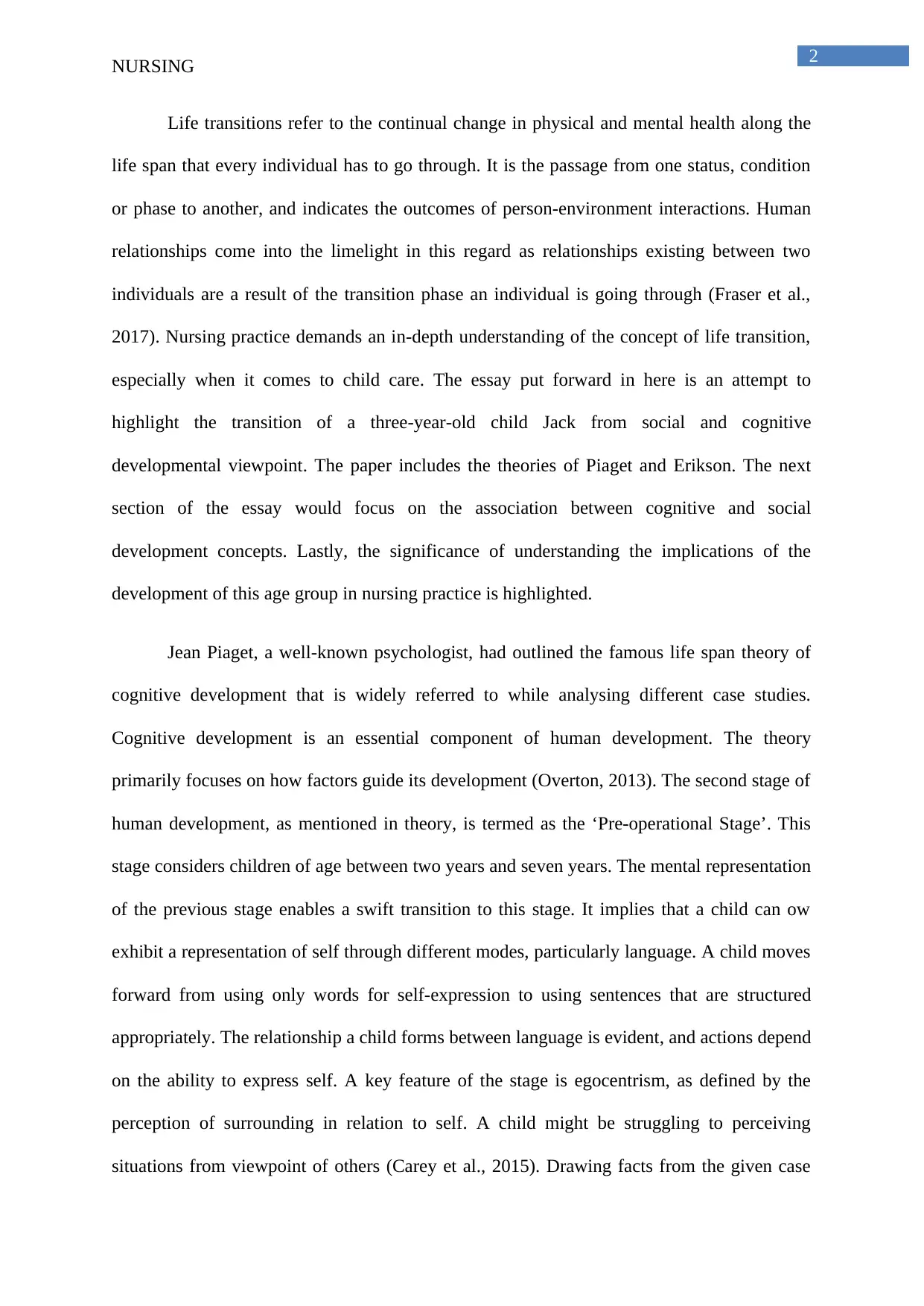
2
NURSING
Life transitions refer to the continual change in physical and mental health along the
life span that every individual has to go through. It is the passage from one status, condition
or phase to another, and indicates the outcomes of person-environment interactions. Human
relationships come into the limelight in this regard as relationships existing between two
individuals are a result of the transition phase an individual is going through (Fraser et al.,
2017). Nursing practice demands an in-depth understanding of the concept of life transition,
especially when it comes to child care. The essay put forward in here is an attempt to
highlight the transition of a three-year-old child Jack from social and cognitive
developmental viewpoint. The paper includes the theories of Piaget and Erikson. The next
section of the essay would focus on the association between cognitive and social
development concepts. Lastly, the significance of understanding the implications of the
development of this age group in nursing practice is highlighted.
Jean Piaget, a well-known psychologist, had outlined the famous life span theory of
cognitive development that is widely referred to while analysing different case studies.
Cognitive development is an essential component of human development. The theory
primarily focuses on how factors guide its development (Overton, 2013). The second stage of
human development, as mentioned in theory, is termed as the ‘Pre-operational Stage’. This
stage considers children of age between two years and seven years. The mental representation
of the previous stage enables a swift transition to this stage. It implies that a child can ow
exhibit a representation of self through different modes, particularly language. A child moves
forward from using only words for self-expression to using sentences that are structured
appropriately. The relationship a child forms between language is evident, and actions depend
on the ability to express self. A key feature of the stage is egocentrism, as defined by the
perception of surrounding in relation to self. A child might be struggling to perceiving
situations from viewpoint of others (Carey et al., 2015). Drawing facts from the given case
NURSING
Life transitions refer to the continual change in physical and mental health along the
life span that every individual has to go through. It is the passage from one status, condition
or phase to another, and indicates the outcomes of person-environment interactions. Human
relationships come into the limelight in this regard as relationships existing between two
individuals are a result of the transition phase an individual is going through (Fraser et al.,
2017). Nursing practice demands an in-depth understanding of the concept of life transition,
especially when it comes to child care. The essay put forward in here is an attempt to
highlight the transition of a three-year-old child Jack from social and cognitive
developmental viewpoint. The paper includes the theories of Piaget and Erikson. The next
section of the essay would focus on the association between cognitive and social
development concepts. Lastly, the significance of understanding the implications of the
development of this age group in nursing practice is highlighted.
Jean Piaget, a well-known psychologist, had outlined the famous life span theory of
cognitive development that is widely referred to while analysing different case studies.
Cognitive development is an essential component of human development. The theory
primarily focuses on how factors guide its development (Overton, 2013). The second stage of
human development, as mentioned in theory, is termed as the ‘Pre-operational Stage’. This
stage considers children of age between two years and seven years. The mental representation
of the previous stage enables a swift transition to this stage. It implies that a child can ow
exhibit a representation of self through different modes, particularly language. A child moves
forward from using only words for self-expression to using sentences that are structured
appropriately. The relationship a child forms between language is evident, and actions depend
on the ability to express self. A key feature of the stage is egocentrism, as defined by the
perception of surrounding in relation to self. A child might be struggling to perceiving
situations from viewpoint of others (Carey et al., 2015). Drawing facts from the given case
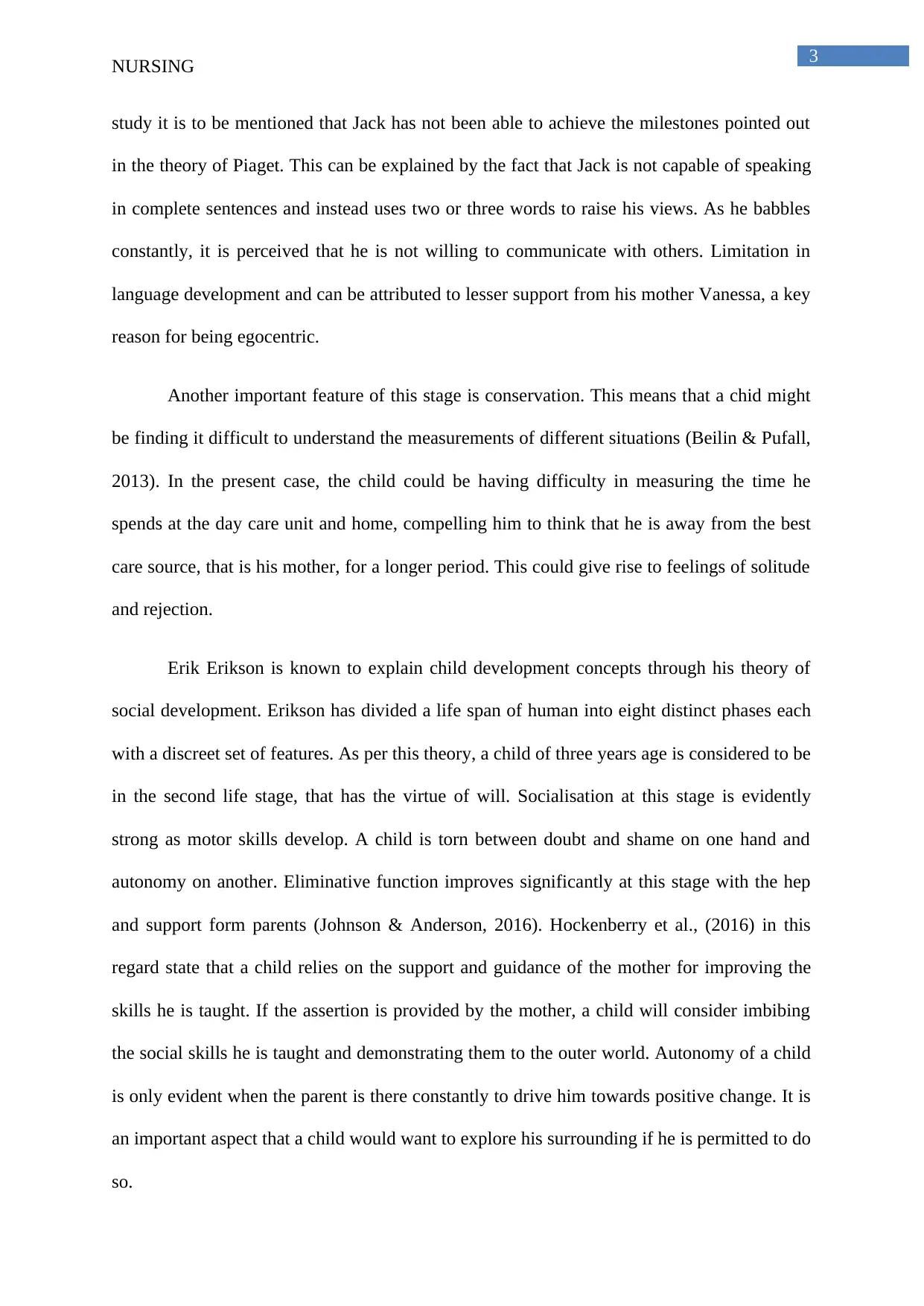
3
NURSING
study it is to be mentioned that Jack has not been able to achieve the milestones pointed out
in the theory of Piaget. This can be explained by the fact that Jack is not capable of speaking
in complete sentences and instead uses two or three words to raise his views. As he babbles
constantly, it is perceived that he is not willing to communicate with others. Limitation in
language development and can be attributed to lesser support from his mother Vanessa, a key
reason for being egocentric.
Another important feature of this stage is conservation. This means that a chid might
be finding it difficult to understand the measurements of different situations (Beilin & Pufall,
2013). In the present case, the child could be having difficulty in measuring the time he
spends at the day care unit and home, compelling him to think that he is away from the best
care source, that is his mother, for a longer period. This could give rise to feelings of solitude
and rejection.
Erik Erikson is known to explain child development concepts through his theory of
social development. Erikson has divided a life span of human into eight distinct phases each
with a discreet set of features. As per this theory, a child of three years age is considered to be
in the second life stage, that has the virtue of will. Socialisation at this stage is evidently
strong as motor skills develop. A child is torn between doubt and shame on one hand and
autonomy on another. Eliminative function improves significantly at this stage with the hep
and support form parents (Johnson & Anderson, 2016). Hockenberry et al., (2016) in this
regard state that a child relies on the support and guidance of the mother for improving the
skills he is taught. If the assertion is provided by the mother, a child will consider imbibing
the social skills he is taught and demonstrating them to the outer world. Autonomy of a child
is only evident when the parent is there constantly to drive him towards positive change. It is
an important aspect that a child would want to explore his surrounding if he is permitted to do
so.
NURSING
study it is to be mentioned that Jack has not been able to achieve the milestones pointed out
in the theory of Piaget. This can be explained by the fact that Jack is not capable of speaking
in complete sentences and instead uses two or three words to raise his views. As he babbles
constantly, it is perceived that he is not willing to communicate with others. Limitation in
language development and can be attributed to lesser support from his mother Vanessa, a key
reason for being egocentric.
Another important feature of this stage is conservation. This means that a chid might
be finding it difficult to understand the measurements of different situations (Beilin & Pufall,
2013). In the present case, the child could be having difficulty in measuring the time he
spends at the day care unit and home, compelling him to think that he is away from the best
care source, that is his mother, for a longer period. This could give rise to feelings of solitude
and rejection.
Erik Erikson is known to explain child development concepts through his theory of
social development. Erikson has divided a life span of human into eight distinct phases each
with a discreet set of features. As per this theory, a child of three years age is considered to be
in the second life stage, that has the virtue of will. Socialisation at this stage is evidently
strong as motor skills develop. A child is torn between doubt and shame on one hand and
autonomy on another. Eliminative function improves significantly at this stage with the hep
and support form parents (Johnson & Anderson, 2016). Hockenberry et al., (2016) in this
regard state that a child relies on the support and guidance of the mother for improving the
skills he is taught. If the assertion is provided by the mother, a child will consider imbibing
the social skills he is taught and demonstrating them to the outer world. Autonomy of a child
is only evident when the parent is there constantly to drive him towards positive change. It is
an important aspect that a child would want to explore his surrounding if he is permitted to do
so.
⊘ This is a preview!⊘
Do you want full access?
Subscribe today to unlock all pages.

Trusted by 1+ million students worldwide
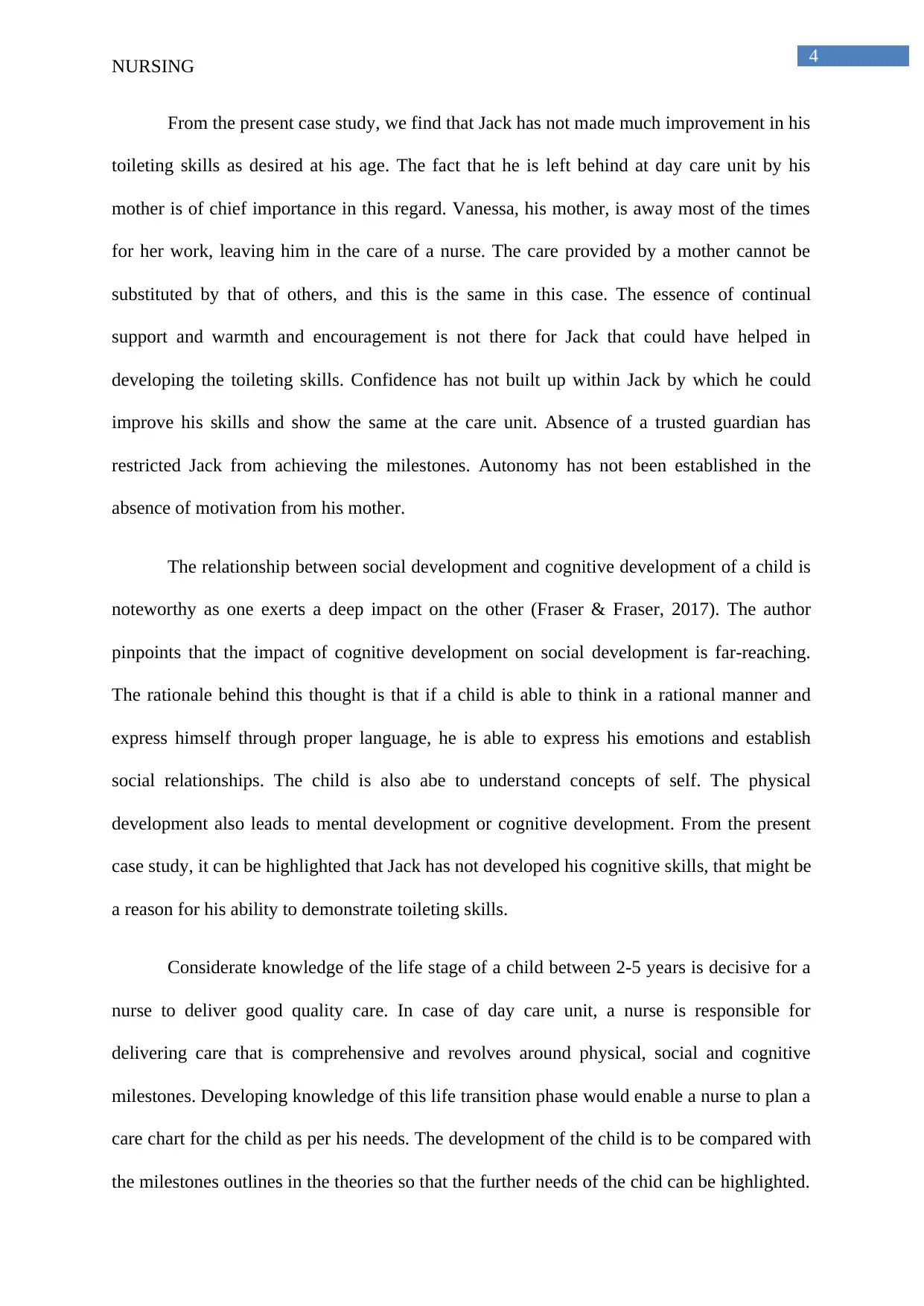
4
NURSING
From the present case study, we find that Jack has not made much improvement in his
toileting skills as desired at his age. The fact that he is left behind at day care unit by his
mother is of chief importance in this regard. Vanessa, his mother, is away most of the times
for her work, leaving him in the care of a nurse. The care provided by a mother cannot be
substituted by that of others, and this is the same in this case. The essence of continual
support and warmth and encouragement is not there for Jack that could have helped in
developing the toileting skills. Confidence has not built up within Jack by which he could
improve his skills and show the same at the care unit. Absence of a trusted guardian has
restricted Jack from achieving the milestones. Autonomy has not been established in the
absence of motivation from his mother.
The relationship between social development and cognitive development of a child is
noteworthy as one exerts a deep impact on the other (Fraser & Fraser, 2017). The author
pinpoints that the impact of cognitive development on social development is far-reaching.
The rationale behind this thought is that if a child is able to think in a rational manner and
express himself through proper language, he is able to express his emotions and establish
social relationships. The child is also abe to understand concepts of self. The physical
development also leads to mental development or cognitive development. From the present
case study, it can be highlighted that Jack has not developed his cognitive skills, that might be
a reason for his ability to demonstrate toileting skills.
Considerate knowledge of the life stage of a child between 2-5 years is decisive for a
nurse to deliver good quality care. In case of day care unit, a nurse is responsible for
delivering care that is comprehensive and revolves around physical, social and cognitive
milestones. Developing knowledge of this life transition phase would enable a nurse to plan a
care chart for the child as per his needs. The development of the child is to be compared with
the milestones outlines in the theories so that the further needs of the chid can be highlighted.
NURSING
From the present case study, we find that Jack has not made much improvement in his
toileting skills as desired at his age. The fact that he is left behind at day care unit by his
mother is of chief importance in this regard. Vanessa, his mother, is away most of the times
for her work, leaving him in the care of a nurse. The care provided by a mother cannot be
substituted by that of others, and this is the same in this case. The essence of continual
support and warmth and encouragement is not there for Jack that could have helped in
developing the toileting skills. Confidence has not built up within Jack by which he could
improve his skills and show the same at the care unit. Absence of a trusted guardian has
restricted Jack from achieving the milestones. Autonomy has not been established in the
absence of motivation from his mother.
The relationship between social development and cognitive development of a child is
noteworthy as one exerts a deep impact on the other (Fraser & Fraser, 2017). The author
pinpoints that the impact of cognitive development on social development is far-reaching.
The rationale behind this thought is that if a child is able to think in a rational manner and
express himself through proper language, he is able to express his emotions and establish
social relationships. The child is also abe to understand concepts of self. The physical
development also leads to mental development or cognitive development. From the present
case study, it can be highlighted that Jack has not developed his cognitive skills, that might be
a reason for his ability to demonstrate toileting skills.
Considerate knowledge of the life stage of a child between 2-5 years is decisive for a
nurse to deliver good quality care. In case of day care unit, a nurse is responsible for
delivering care that is comprehensive and revolves around physical, social and cognitive
milestones. Developing knowledge of this life transition phase would enable a nurse to plan a
care chart for the child as per his needs. The development of the child is to be compared with
the milestones outlines in the theories so that the further needs of the chid can be highlighted.
Paraphrase This Document
Need a fresh take? Get an instant paraphrase of this document with our AI Paraphraser
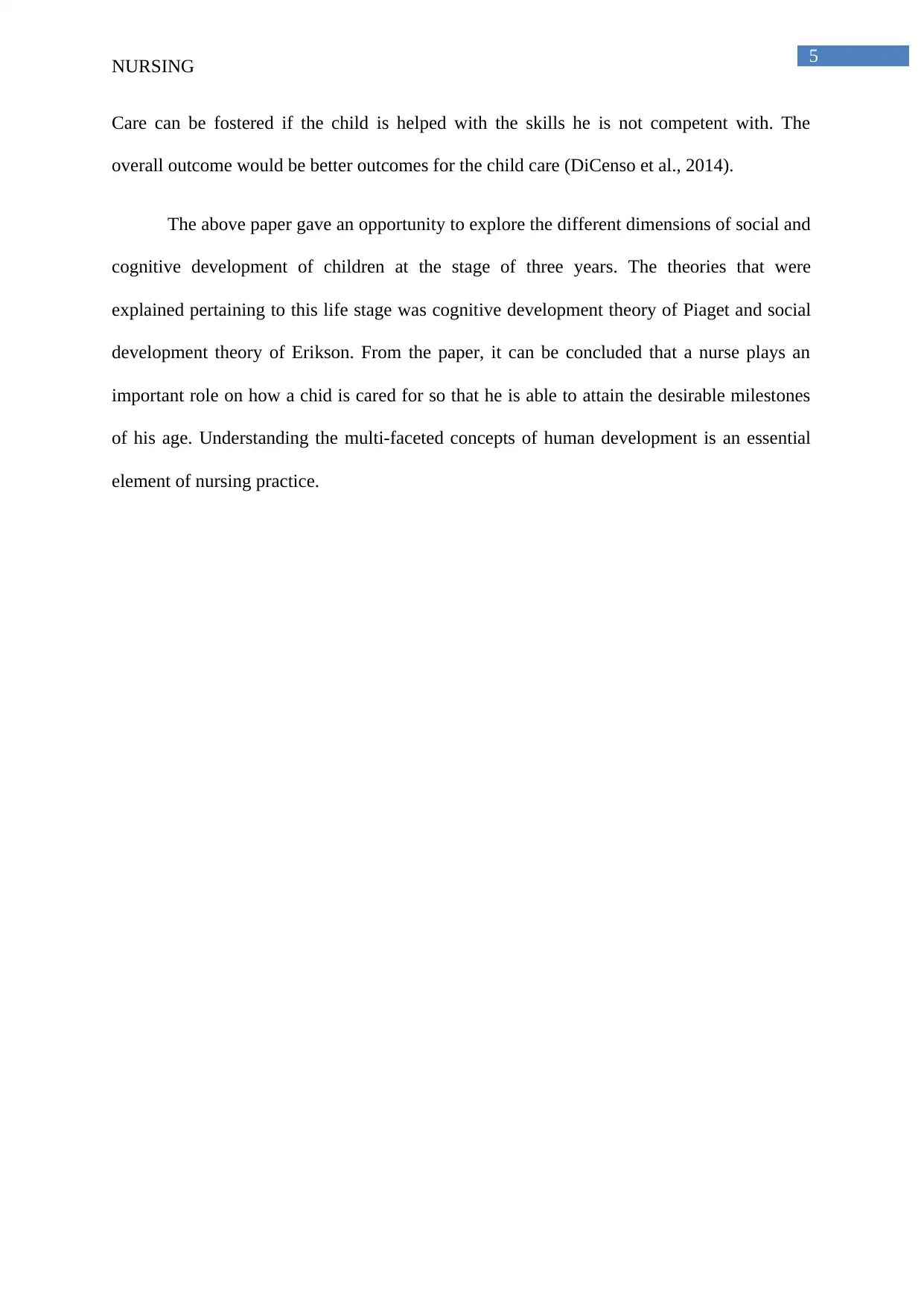
5
NURSING
Care can be fostered if the child is helped with the skills he is not competent with. The
overall outcome would be better outcomes for the child care (DiCenso et al., 2014).
The above paper gave an opportunity to explore the different dimensions of social and
cognitive development of children at the stage of three years. The theories that were
explained pertaining to this life stage was cognitive development theory of Piaget and social
development theory of Erikson. From the paper, it can be concluded that a nurse plays an
important role on how a chid is cared for so that he is able to attain the desirable milestones
of his age. Understanding the multi-faceted concepts of human development is an essential
element of nursing practice.
NURSING
Care can be fostered if the child is helped with the skills he is not competent with. The
overall outcome would be better outcomes for the child care (DiCenso et al., 2014).
The above paper gave an opportunity to explore the different dimensions of social and
cognitive development of children at the stage of three years. The theories that were
explained pertaining to this life stage was cognitive development theory of Piaget and social
development theory of Erikson. From the paper, it can be concluded that a nurse plays an
important role on how a chid is cared for so that he is able to attain the desirable milestones
of his age. Understanding the multi-faceted concepts of human development is an essential
element of nursing practice.
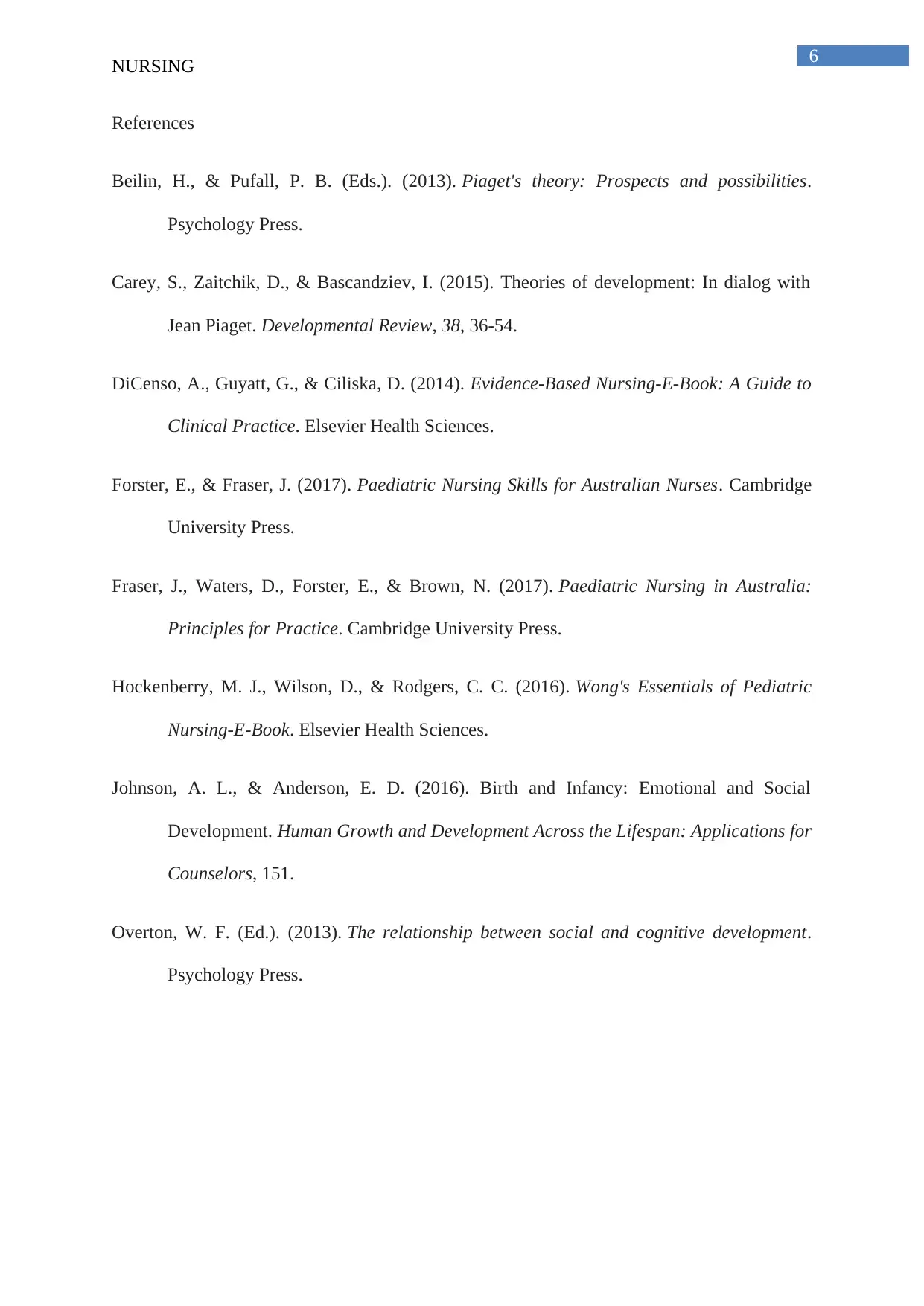
6
NURSING
References
Beilin, H., & Pufall, P. B. (Eds.). (2013). Piaget's theory: Prospects and possibilities.
Psychology Press.
Carey, S., Zaitchik, D., & Bascandziev, I. (2015). Theories of development: In dialog with
Jean Piaget. Developmental Review, 38, 36-54.
DiCenso, A., Guyatt, G., & Ciliska, D. (2014). Evidence-Based Nursing-E-Book: A Guide to
Clinical Practice. Elsevier Health Sciences.
Forster, E., & Fraser, J. (2017). Paediatric Nursing Skills for Australian Nurses. Cambridge
University Press.
Fraser, J., Waters, D., Forster, E., & Brown, N. (2017). Paediatric Nursing in Australia:
Principles for Practice. Cambridge University Press.
Hockenberry, M. J., Wilson, D., & Rodgers, C. C. (2016). Wong's Essentials of Pediatric
Nursing-E-Book. Elsevier Health Sciences.
Johnson, A. L., & Anderson, E. D. (2016). Birth and Infancy: Emotional and Social
Development. Human Growth and Development Across the Lifespan: Applications for
Counselors, 151.
Overton, W. F. (Ed.). (2013). The relationship between social and cognitive development.
Psychology Press.
NURSING
References
Beilin, H., & Pufall, P. B. (Eds.). (2013). Piaget's theory: Prospects and possibilities.
Psychology Press.
Carey, S., Zaitchik, D., & Bascandziev, I. (2015). Theories of development: In dialog with
Jean Piaget. Developmental Review, 38, 36-54.
DiCenso, A., Guyatt, G., & Ciliska, D. (2014). Evidence-Based Nursing-E-Book: A Guide to
Clinical Practice. Elsevier Health Sciences.
Forster, E., & Fraser, J. (2017). Paediatric Nursing Skills for Australian Nurses. Cambridge
University Press.
Fraser, J., Waters, D., Forster, E., & Brown, N. (2017). Paediatric Nursing in Australia:
Principles for Practice. Cambridge University Press.
Hockenberry, M. J., Wilson, D., & Rodgers, C. C. (2016). Wong's Essentials of Pediatric
Nursing-E-Book. Elsevier Health Sciences.
Johnson, A. L., & Anderson, E. D. (2016). Birth and Infancy: Emotional and Social
Development. Human Growth and Development Across the Lifespan: Applications for
Counselors, 151.
Overton, W. F. (Ed.). (2013). The relationship between social and cognitive development.
Psychology Press.
⊘ This is a preview!⊘
Do you want full access?
Subscribe today to unlock all pages.

Trusted by 1+ million students worldwide
1 out of 6
Related Documents
Your All-in-One AI-Powered Toolkit for Academic Success.
+13062052269
info@desklib.com
Available 24*7 on WhatsApp / Email
![[object Object]](/_next/static/media/star-bottom.7253800d.svg)
Unlock your academic potential
Copyright © 2020–2025 A2Z Services. All Rights Reserved. Developed and managed by ZUCOL.





